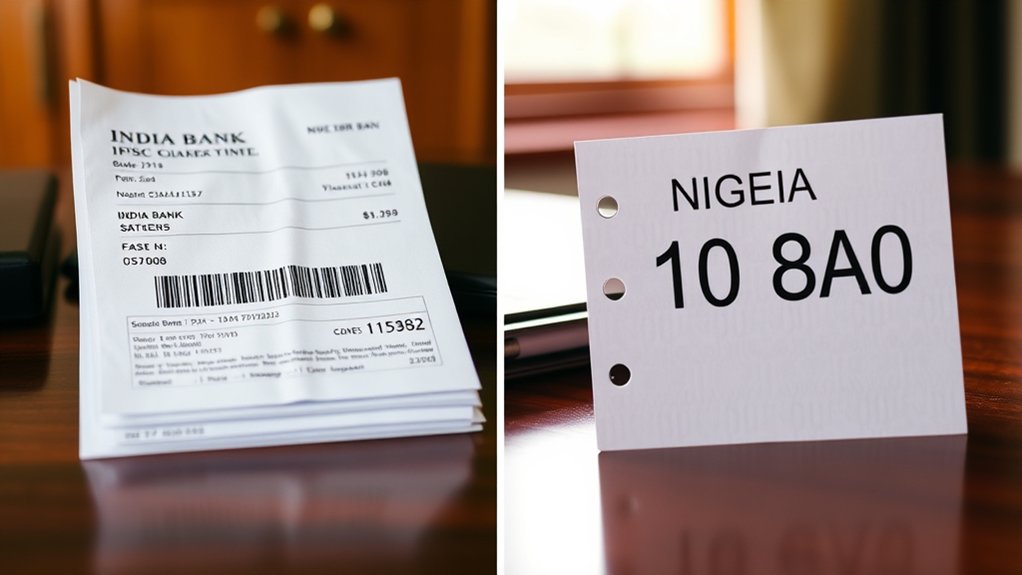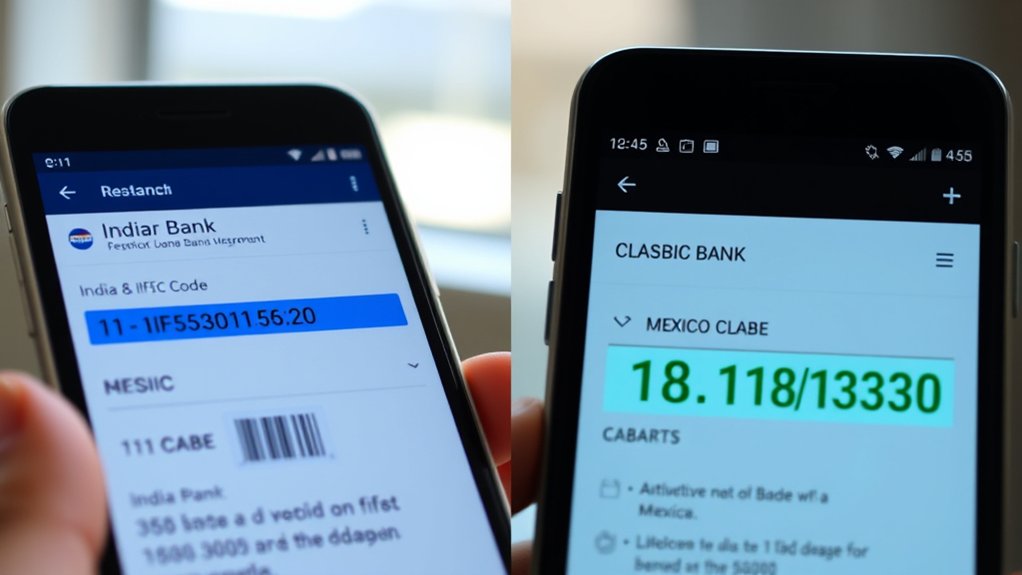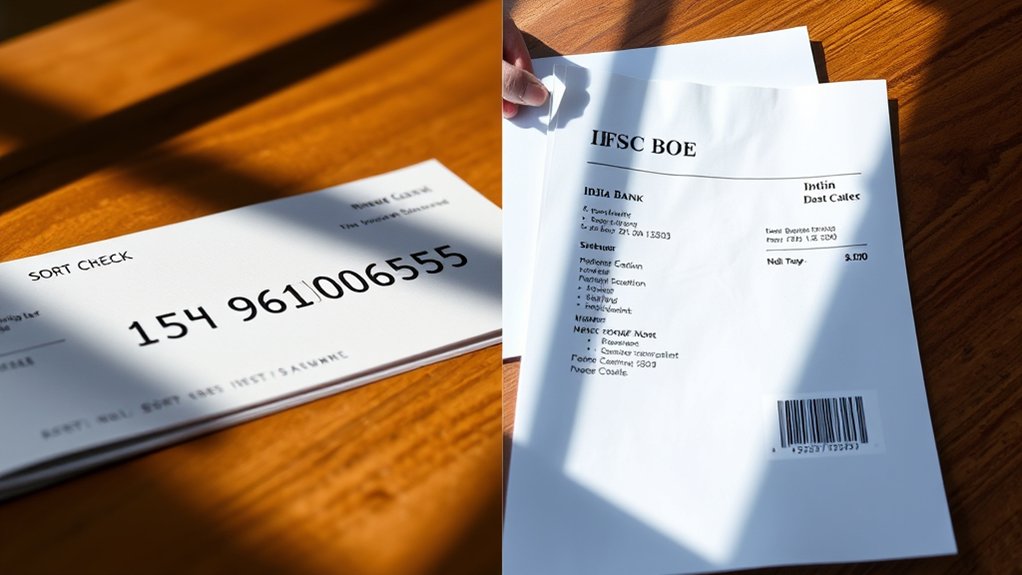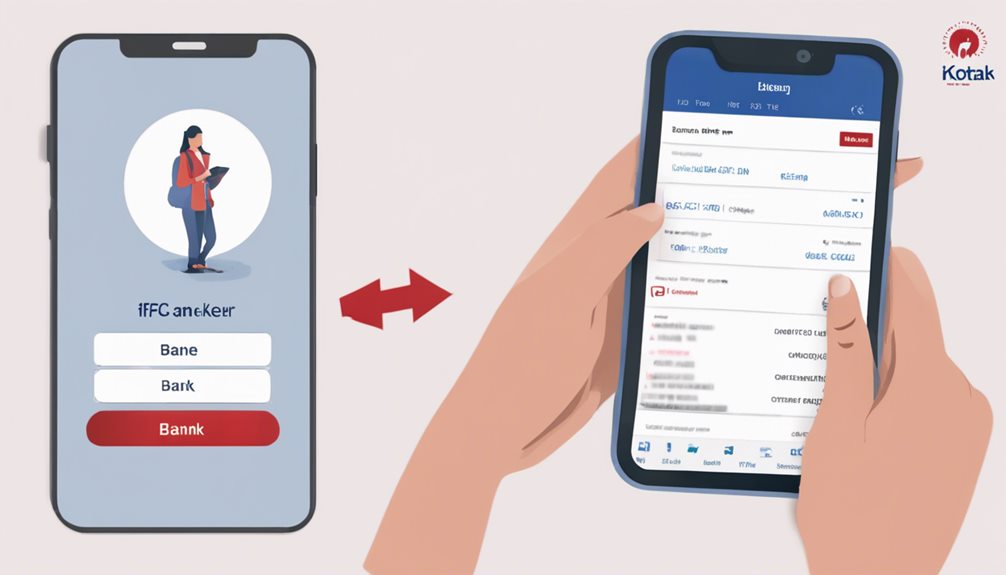
You can safely share your IFSC code since it’s a public routing identifier that doesn’t contain sensitive account information. The 11-digit alphanumeric code simply helps banks identify specific branches for electronic fund transfers like NEFT and RTGS. While sharing IFSC codes is secure, you should still verify the recipient’s identity and never disclose associated PINs or OTPs. Understanding additional security protocols can enhance your protection during banking transactions.
Understanding IFSC Code Fundamentals
The Indian Financial System Code serves as a critical identifier in India’s banking infrastructure, enabling secure electronic fund transfers between financial institutions.
When you’re conducting NEFT, RTGS, or IMPS transactions, you’ll need to understand the IFSC code’s importance as a unique 11-digit alphanumeric sequence. The code’s structure follows a precise format: four characters identify the bank, followed by a ‘0’ separator, and six characters pinpoint the specific branch.
While IFSC code misuse is a concern, the system’s design by the RBI guarantees transaction security through this standardized identification method.
You’ll find your IFSC code on bank-issued documents like passbooks and cheques, or through the RBI’s official website. This accessibility helps you verify and use the correct code, preventing transaction failures and guaranteeing accurate fund transfers.
Key Security Features of IFSC Codes
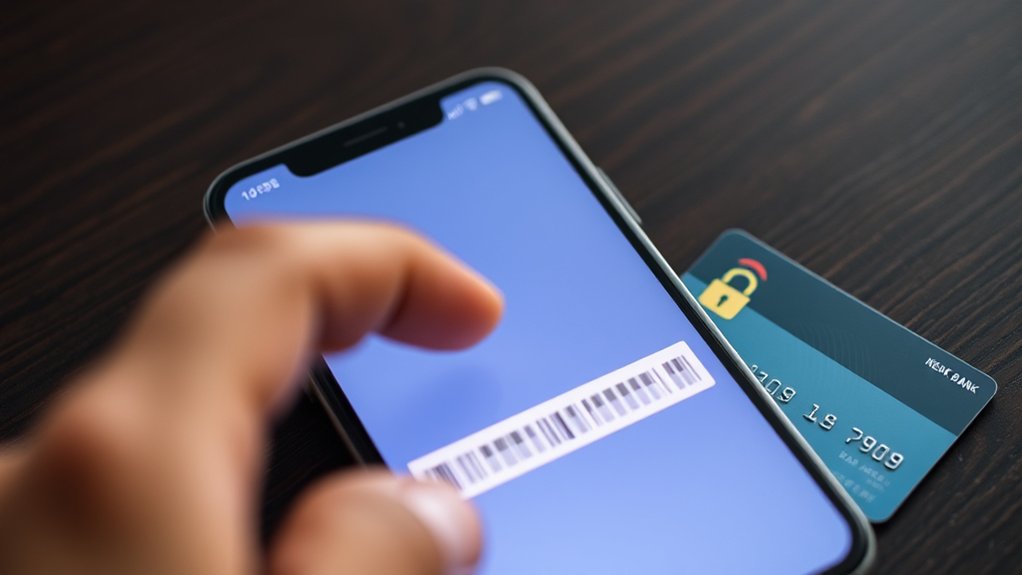
Your bank’s IFSC code incorporates a robust Multiple Layer Authentication System that works in tandem with Digital Encryption Protocols to prevent unauthorized access during transactions.
These security features guarantee that each time you initiate a fund transfer, the system validates the Branch-Specific Verification Codes against a centralized database for accuracy and authenticity.
The integration of these three security components creates an interlocking system that makes IFSC codes highly resistant to tampering while maintaining their effectiveness for legitimate banking operations.
Multiple Layer Authentication System
While sharing IFSC codes might raise security concerns, modern banking systems employ robust multi-layer authentication protocols that extend far beyond the code itself.
Your transactions are protected by multiple authentication methods, including mandatory OTP verification, which serves as a critical security checkpoint during fund transfers.
The system’s sophisticated monitoring capabilities actively track transaction patterns and instantly alert you to any suspicious activities.
When you initiate a transfer, the bank’s encryption technology works alongside the IFSC code’s inherent 11-character secure structure to combat security challenges.
This extensive authentication framework guarantees that even if someone obtains your IFSC code, they can’t execute unauthorized transactions without clearing additional security hurdles.
The integration of these safeguards effectively transforms the IFSC code from a simple identifier into part of a robust security ecosystem.
Digital Encryption Protocols
Modern encryption protocols form the backbone of IFSC code security, operating through sophisticated digital algorithms that protect each transaction. When you initiate a transfer, your bank’s digital key management system immediately encrypts the IFSC code data, making it virtually impenetrable to unauthorized access.
The secure transaction protocols implemented by Indian banks follow RBI’s stringent standards, guaranteeing that your sensitive information remains protected throughout the transfer process.
You’ll notice this security in action through mandatory OTP verifications and multi-factor authentication steps. These encryption measures work in tandem with the IFSC’s built-in control point mechanism, creating a robust defense against potential security breaches.
Your adherence to basic security practices, combined with these sophisticated encryption protocols, guarantees that your transactions remain secure within the banking network.
Branch-Specific Verification Codes
The branch-specific verification component of IFSC codes functions as a critical security layer within India’s electronic banking infrastructure. The six-character branch identification segment enables precise location and verification of your intended recipient’s banking facility, ensuring transaction accuracy across India’s vast banking network.
- Your transfers benefit from RBI’s stringent oversight through unique branch codes
- You’ll experience enhanced security with the ‘0’ separator that distinctly marks branch identifiers
- Your transaction routing becomes foolproof with branch-specific verification
- You can validate recipient branch details independently before fund transfers
- Your electronic payments maintain compliance with RBI’s standardized identification system
This verification system integrates seamlessly with NEFT, RTGS, and IMPS protocols, providing you with a robust framework for secure fund transfers while maintaining the integrity of inter-bank transactions.
Safe Practices When Sharing IFSC Details
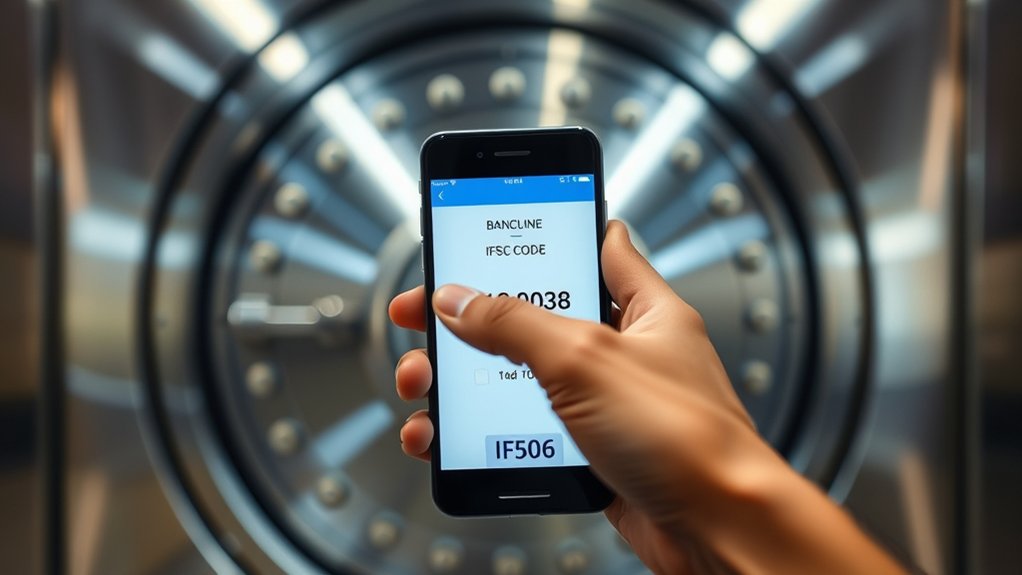
Following established security protocols when sharing IFSC codes is essential for maintaining transaction safety and preventing potential fraud. When implementing best practices, you’ll need to verify the recipient’s identity and confirm the legitimate purpose of your transaction before disclosing your IFSC details.
The sharing guidelines emphasize that you should never reveal your IFSC code publicly or to unverified parties. While it’s safe to share this code for genuine transactions, you must remain vigilant about protecting associated sensitive information.
Remember that authentic bank representatives won’t request your PIN or OTP when discussing IFSC codes. By adhering to these protocols, you’re leveraging the IFSC system’s built-in security features, which serve as control points for monitoring and validating inter-bank electronic transfers.
Common Risks and Misconceptions
Understanding common misconceptions about IFSC code security can help you distinguish between real and perceived risks.
You’ll find that many concerns about IFSC code sharing stem from misunderstandings about transaction safety and banking protocols.
- The belief that sharing an IFSC code exposes your account to unauthorized access is incorrect – criminals can’t perform transactions with this information alone.
- Some mistakenly think bank employees requesting IFSC codes are scammers, when it’s actually standard practice for legitimate transactions.
- The misconception that IFSC codes contain sensitive account details undermines confidence in secure banking systems.
- You might worry that sharing IFSC codes bypasses encryption protocols, but banks maintain robust security regardless.
- The fear that IFSC codes can be used for identity theft is unfounded when proper banking practices are followed.
How Banks Protect Your IFSC Transactions
Your bank employs multi-layered security protocols and advanced digital encryption standards to protect every transaction that uses an IFSC code.
Sophisticated fraud detection systems continuously monitor transaction patterns and automatically flag suspicious activities, while sending you real-time alerts about any unauthorized access attempts.
These protective measures work in conjunction with mandatory verification requirements, such as PINs and OTPs, creating a robust security framework that makes IFSC-based transactions highly secure.
Security Layers and Protocols
Banks employ multiple layers of sophisticated security protocols to safeguard IFSC-based transactions, creating a robust defense against potential cyber threats. Through rigorous transaction monitoring and security audits, your financial data remains protected within the banking system’s encrypted infrastructure.
- Advanced encryption technology shields your IFSC transactions from unauthorized access and cyber attacks.
- Real-time transaction monitoring systems detect and flag suspicious activities instantly.
- Two-factor authentication with OTP verification guarantees only authorized users can complete transfers.
- Automated alert systems notify you immediately of any unusual account activity.
- Bank personnel protocols prevent social engineering attempts by never requesting sensitive authentication data.
These multilayered security measures work in concert to maintain the integrity of your IFSC-based transactions while enabling seamless fund transfers within the banking network.
Fraud Detection Systems
To protect millions of daily IFSC transactions, sophisticated fraud detection systems continuously analyze transfer patterns and account behaviors in real-time.
These systems employ advanced anomaly detection algorithms that flag unusual activities that deviate from your normal transaction patterns.
When you initiate an IFSC transfer, transaction monitoring tools scrutinize multiple data points, including transfer amount, recipient history, and geographic location.
If the system detects suspicious patterns, it triggers immediate alerts to both the bank’s security team and you.
You’ll receive instant notifications via text or email about incoming funds and potentially fraudulent activities.
This multi-layered approach, combined with mandatory OTP verification, guarantees that your transfers remain secure.
Regular security audits by regulatory authorities like the RBI further strengthen these protective measures, making IFSC transactions highly secure.
Digital Encryption Standards
When protecting IFSC transactions, high-grade encryption standards form the backbone of digital security protocols. Banks deploy sophisticated encryption algorithms and secure protocols to safeguard your financial data during transmission.
- SSL and TLS encryption guarantees your transaction data remains encrypted while traveling through digital channels.
- PCI DSS compliance assures that banks maintain international security standards for handling your sensitive information.
- Multi-factor authentication protocols add an extra layer of protection by requiring identity verification through OTPs.
- Real-time monitoring systems actively scan for suspicious activities and unauthorized access attempts.
- High-security settings prevent unauthorized users from intercepting or manipulating your IFSC transactions.
These extensive encryption measures work together to create an impenetrable shield around your financial transactions, making IFSC-based transfers one of the most secure methods of moving funds electronically.
Essential Guidelines for Online Banking Security
While sharing your IFSC code remains generally secure, implementing robust online banking security measures safeguards your financial transactions from potential threats.
To enhance transaction safety, you’ll need to establish a vigilant monitoring system for your account activities and enable real-time alerts for all transactions.
Follow these critical online banking tips: never disclose sensitive information like PINs or OTPs, even if requested by someone claiming to be bank personnel.
Verify the legitimacy of any party requesting your IFSC code, and maintain a record of whom you’ve shared it with.
Configure your banking app’s security features to their maximum settings, including two-factor authentication when available.
Should you notice any unauthorized transactions or suspicious activities, contact your bank immediately to prevent potential fraud.
Recognizing and Avoiding IFSC-Related Scams
How can you spot potential scams targeting your IFSC code? Understanding phishing awareness and transaction safety is essential for protecting your banking information. Criminals often deploy sophisticated tactics to exploit unsuspecting individuals through seemingly legitimate requests.
- Never share sensitive details like PINs or OTPs, even if requested alongside IFSC information.
- Report unsolicited banking information requests to your bank immediately.
- Verify the authenticity of any source requesting your IFSC code.
- Monitor your bank statements regularly for unauthorized transactions.
- Be skeptical of urgent or threatening messages demanding banking details.
Remember that while sharing an IFSC code is generally safe for legitimate transactions, scammers may use it as a starting point to gather additional sensitive information.
Stay vigilant and maintain strict security protocols to protect your financial assets.


